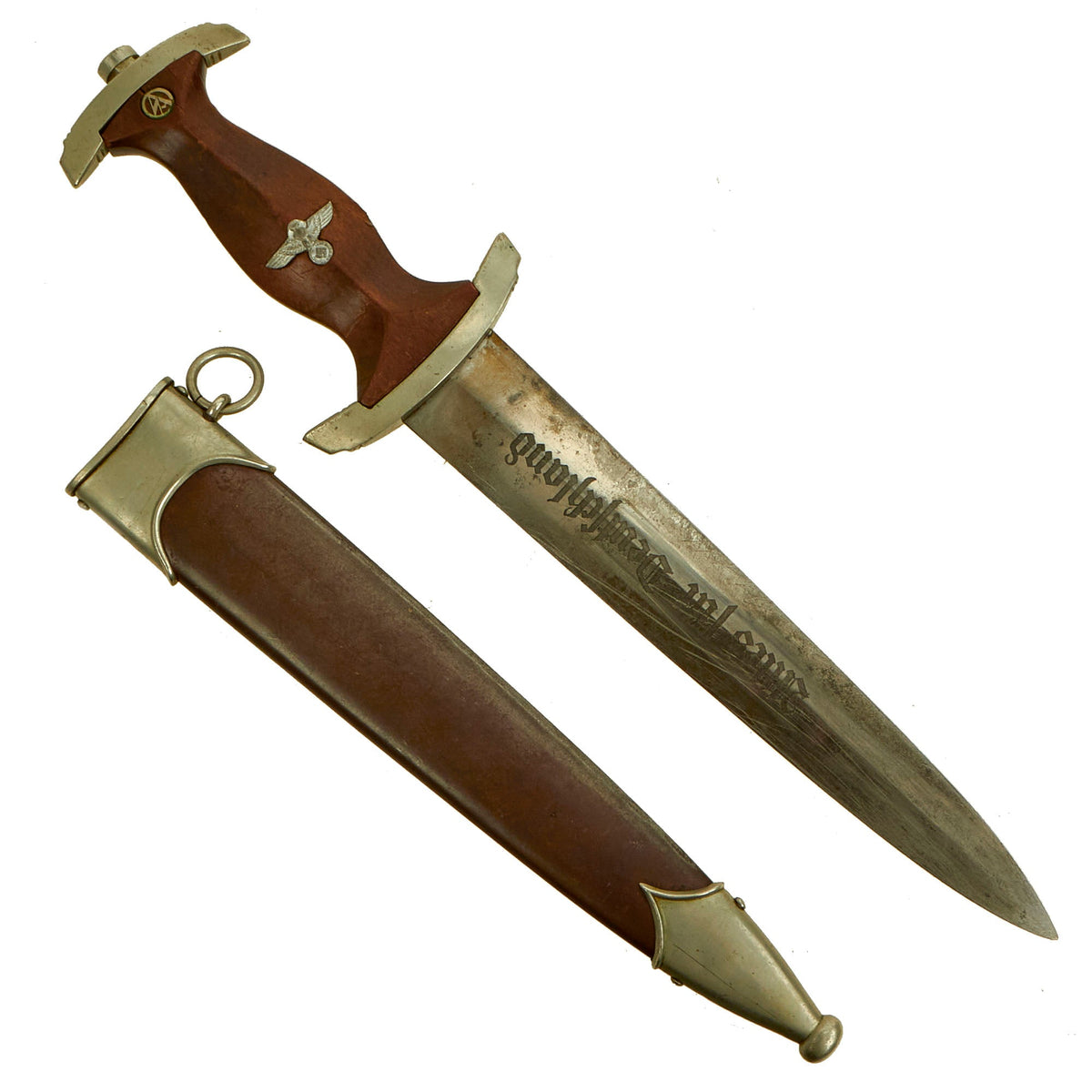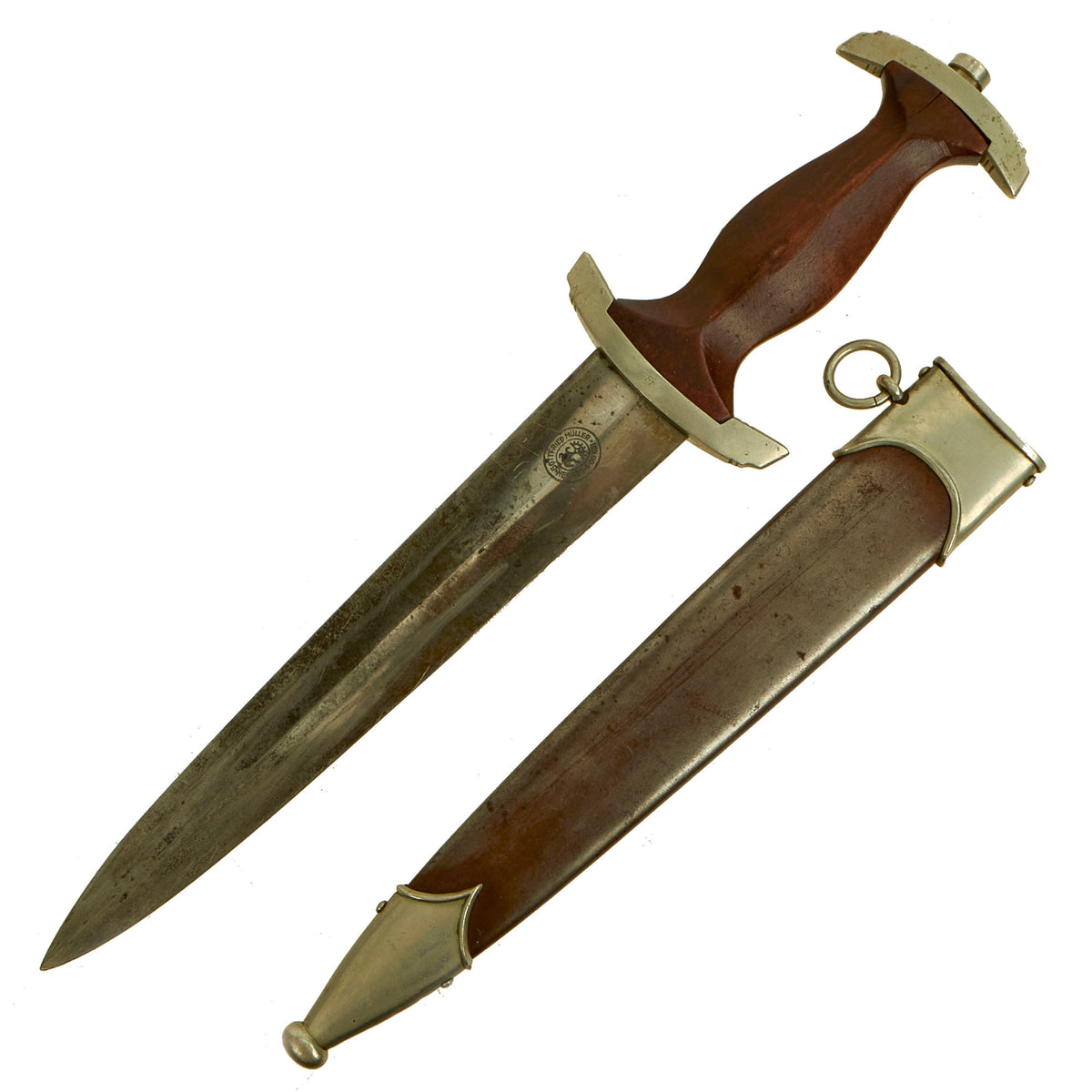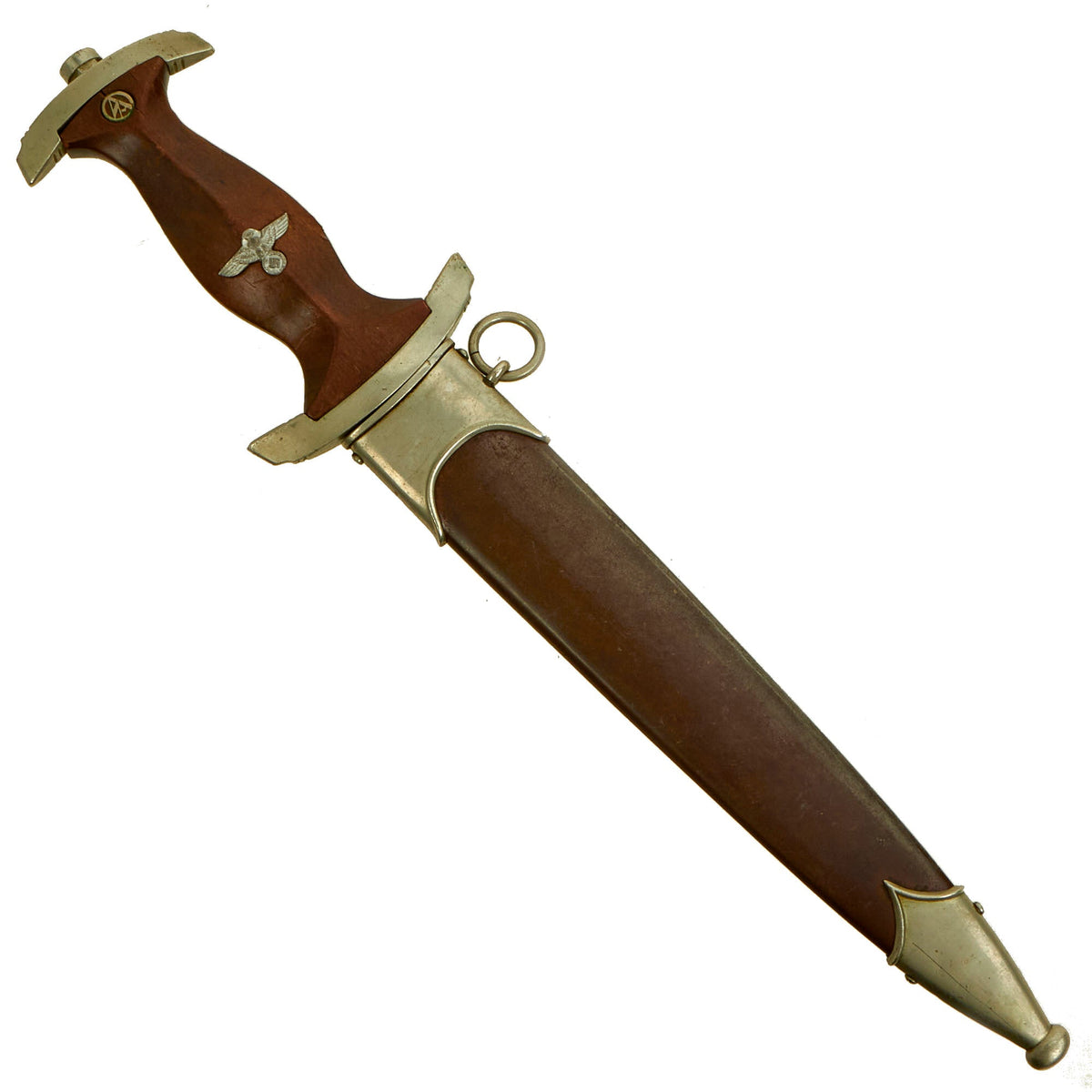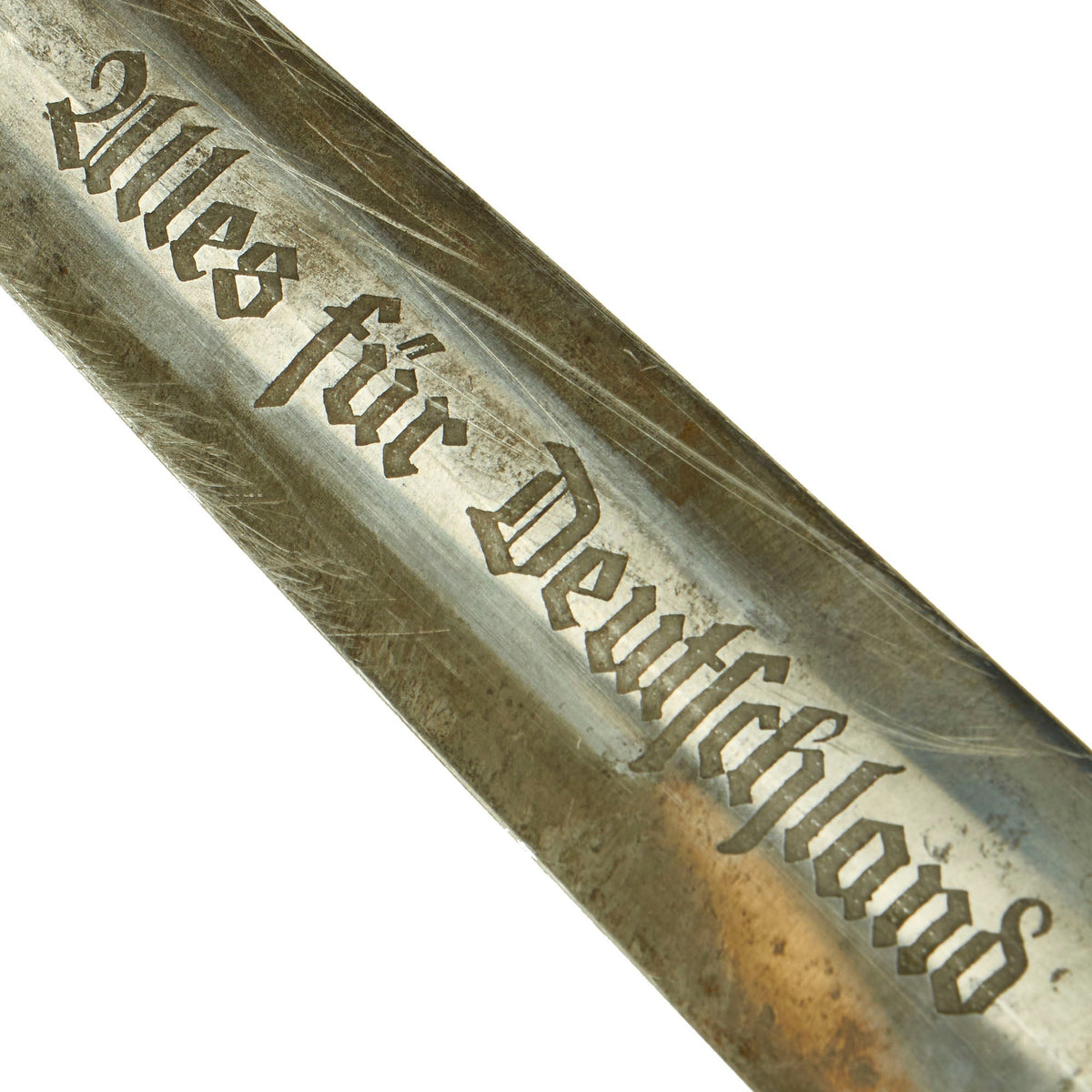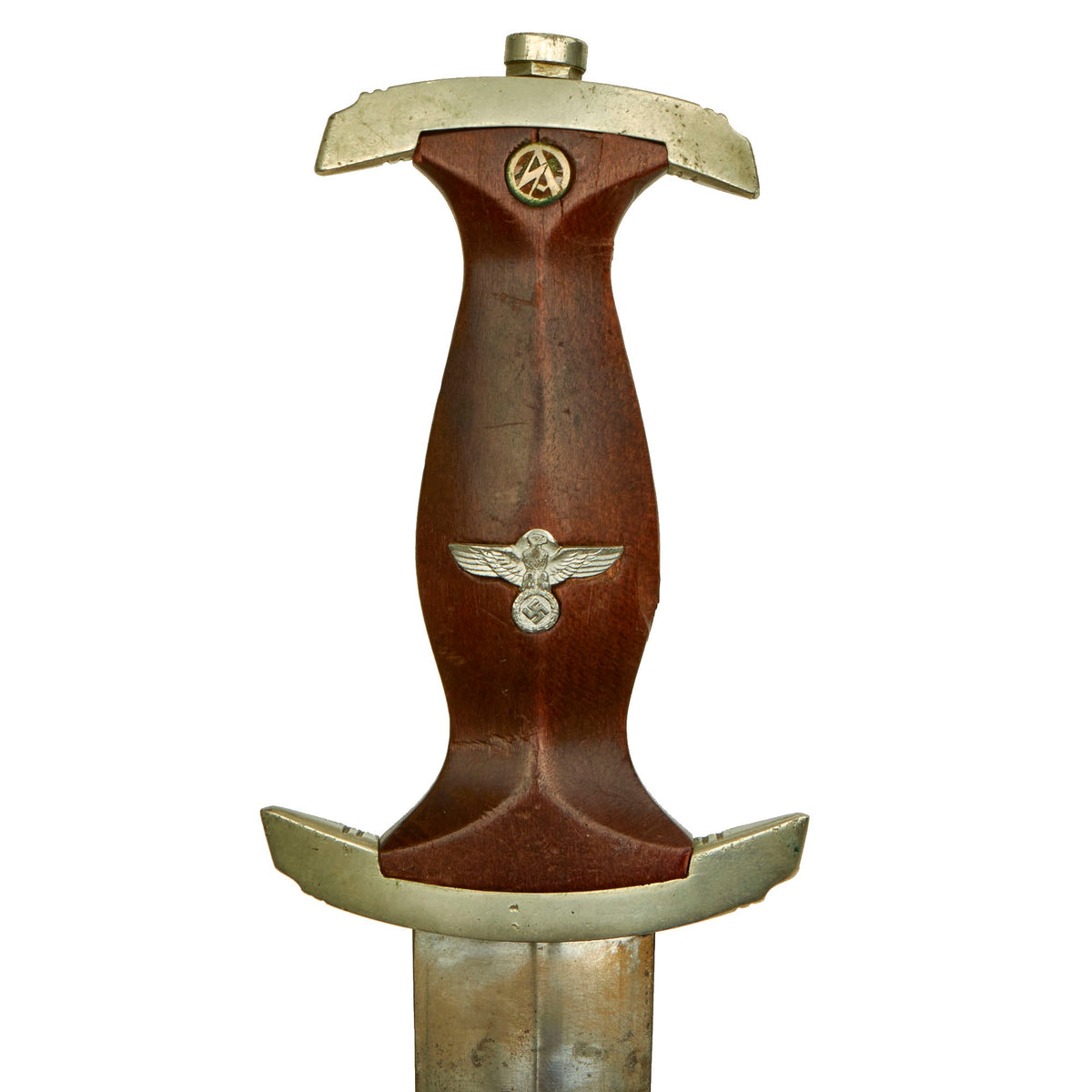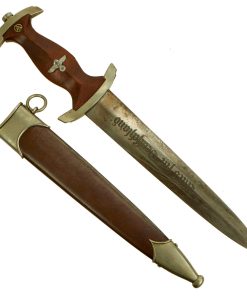Original German Early WWII SA Dagger by Rare Maker Gottfried Müller of Herges-Vogtei with Scabbard Original Items
$ 795,00 $ 238,50
Original Item: Only One Available. This is an very good condition early pattern SA Dagger, made by the very rare firm of Gottfried Müller, Stahlwarenfabrik (Steelware Factory), located in Herges-Vogtei, Germany. This company is known for making early pattern SA daggers, but only made them in limited numbers. It comes comes compete with an original scabbard, which is in very good shape.
The dagger has solid nickel silver fittings throughout, and is a very nice example. The crossguards and tang nut are in very good condition throughout with all fittings having a nice lightly aged patina. There is some age to these mounts but there is no lifting anywhere, showing that they are solid and not plated. They show only light wear with just a bit of light denting and scratching. The pommel guard however must have taken a blow at some point, as it is now tilted due to the tang itself being bent by the securing nut. The lower reverse guard is Gruppe/Gau marked Fr, for Franken, a district in west central Germany, with the principal cities being Nürnberg (Nuremberg) and Suhl. This feature was only seen on daggers produced 1935 and prior.
The grip is a fine product having a lovely dark reddish brown color, with medium center ridge construction, showing the expected wear from service. It is cracked and slightly deformed on one side by the pommel guard, due to the blow it must have taken, which pushed the guard into the wood. Otherwise, it is in good condition and fits the crossguards nicely, though there is a hairline crack between the pommel and the inlaid emblem. The pommel nut does show some turning on the outside, and the grip is still tightly secured, with no wiggle.
The SA symbol button is still present, but the damage to the pommel has moved it slightly an enlarged the inlet. It still has most of the plating, now oxidized with some verdigris, and the translucent enamel is cracked, probably retained at 50%. The grip eagle is a fine example being the style with beak that points straight. It looks to be made from zinc, and does show some wear. However most of the details are still there, including the beak, breast feathering, wing feathering, talons, wreath and mobile swas (hook cross).
The blade is in very good condition, still showing much of the original factory final grind cross grain on both sides. This texture is iconic, and is the definitive identifying characteristic for a real WWII German Blade. There is however light staining and surface oxidation on much of the blade surface, except where it has been polished away by the runner wear. It also looks like the edge may have been sharpened slightly, and there is also a lot of scratching near the edge. The acid-etched Alles für Deutschland (Everything for Germany) SA motto is crisp, with the factory darkening still very well retained.
This fine example was produced by very rare maker Gottfried Müller Stahlwarenfabrik (Steelware Factory) of Herges-Vogtei, and the rear of the dagger is marked with the company’s trademark “demi-cogwheel” logo inside an oval “losenge” with the maker name and address:
GOTTFRIED MÜLLER
* (Logo) *
HERGES-VOGTEI
According to J. Anthony Carter’s book, GERMAN KNIFE AND SWORD MAKERS, this company was located in a rural area more known for agriculture and horticulture. However the area did have a mining and smelting industry beginning in 1750, and Müller opened a factory that initially manufactured mostly scythes, but then expanded to become an important industrial plant in the area. By 1928 they were listed in DRAB as making many types of cutlery. They are known mainly for making early SA daggers with the oval trademark logo, and do not seem to have made any other types of weapons for the war effort.
The scabbard shell is straight throughout and is the early-war style, which were produced with a brown “anodized” finish on the steel, which was then lacquered. This example has lost almost all of the lacquer finish, with traces left near the fittings. However it still retains lots of the original anodized finish, and this is definitely one of the better examples we have seen, with no dents on the body we can see. The upper and lower fittings are solid nickel silver, with a great look and some dents and scratches showing typical wear. The chape is lightly dented at the end, though not split, as the nickel alloy is somewhat soft, making this a common thing to see. The throat nicely matches the crossguards, and all fittings have their original dome headed screws.
A very nice early war SA dagger from a rare maker, complete with a great original scabbard. Ready to display!
Specifications:
Blade Length: 8 3/4″
Overall length: 13 3/4”
Crossguard: 3”
Scabbard Length: 10”
History of the SA-
The SA or Brown Shirts, were a private political formation which Adolf AH and the NSDAP used to maintain order at organized Party meetings and demonstrations. The group was formed in 1921, and grew to a huge force of nearly 3,000,000 men by the later 1930’s. To instill esprit de corps, as well as create employment for the Blade City of Solingen, it was decided each SA man would carry a dagger with his Brown Shirt uniform. Huge quantities needed to be produced to accommodate the demand. The dagger initially was produced of hand-fitted nickel mounts with attractive finished wood grip and brown anodized (a bluing process) finished scabbard.
The blade was etched with the SA motto, Alles für Deutschland. Examples produced prior to 1935 were stamped with the German sector of the SA group on reverse lower crossguard. Later examples underwent standardization through the RZM ministry. These pieces were produced of cheaper plated zinc-base fittings and scabbards were simply painted brown.
Prior to his “unmasking” as a traitor, Ernst Röhm was the leader of the SA. In 1934, he distributed approximately 100,000 SA daggers with his personal inscription on the reverse blade. These daggers were to honor individuals who had served with the SA prior to December, 1931. Other than the inscription, these pieces were identical to the standard M1933 SA dagger. After the Röhm purge, the inscription was ordered to be removed. Many examples were returned to the factory for grinding. Others were simply ground in the field by whatever means were available. Examples will occasionally be encountered with remnants of the original inscription remaining on the blade, but mostly none will remain. Some blades exist with an intact inscription, reflecting only the removal of the Röhm signature. Very very rarely is an example seen with a full, untouched inscription, as the holder would have surely risked a charge of treason.
Fast Shipping with Professional Packaging
Thanks to our longstanding association with UPS FedEx DHL, and other major international carriers, we are able to provide a range of shipping options. Our warehouse staff is expertly trained and will wrap your products according to our exact and precise specifications. Prior to shipping, your goods will be thoroughly examined and securely secured. We ship to thousands clients each day across multiple countries. This shows how we're dedicated to be the largest retailer on the internet. Warehouses and distribution centres can be located throughout Europe as well as the USA.
Note: Orders with more than one item will be assigned a processing date depending on the item.
Before shipping before shipping, we'll conduct a thorough inspection of the items you have ordered. Today, the majority of orders will be delivered within 48 hours. The delivery time will be between 3-7 days.
Returns
The stock is dynamic and we cannot completely manage it because multiple stakeholders are involved, including our factory and warehouse. So the actual stock may alter at any time. It's possible that you may not receive your order once the order has been made.
Our policy is valid for a period of 30 days. If you don't receive the product within 30 days, we are not able to issue a refund or an exchange.
You can only return an item if it is unused and in the same state as the day you received it. You must have the item in its original packaging.
Related products
Uncategorized
Armored Burgonet Helmet & Polearm from Scottish Castle Leith Hall Circa 1700 Original Items
Uncategorized
Uncategorized
Uncategorized
Uncategorized
Australian WWII Owen MK1 Machine Carbine SMG Custom Fabricated Replica with Sling Original Items
Uncategorized
Uncategorized
Uncategorized
Uncategorized
Uncategorized
Uncategorized
Uncategorized
Uncategorized
Uncategorized
Uncategorized
Uncategorized
Uncategorized
Uncategorized
Angolan Rebel 1970s era 60mm Inert Display Mortar from Angolan Civil War Original Items
